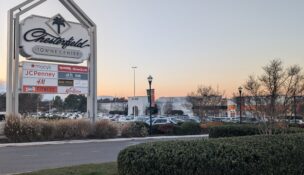Virginia expands rural broadband with fiber focus
Virginia aims to complete internet access project

Bedford County’s John Putney and state broadband office director Tamarah Holmes say the Virginia residences without internet access in 2025 are those that are “hardest to reach.” Photo by Don Petersen

Bedford County’s John Putney and state broadband office director Tamarah Holmes say the Virginia residences without internet access in 2025 are those that are “hardest to reach.” Photo by Don Petersen
Virginia expands rural broadband with fiber focus
Virginia aims to complete internet access project
Summary
- Virginia has connected over 250,000 rural locations with state and federal broadband funding
- 133,000 addresses remain unserved, mostly in hard-to-reach areas
- Officials criticize federal shift toward satellite over fiber internet
- State invests in pole upgrades, permit reforms to speed fiber deployment
A student in class on a snow day. An elderly couple checking in with their doctor instead of driving to an office. A dairy farmer coordinating automatic milking machines hooked up to cows.
All three examples include a commonality in today’s increasingly digital world: internet access.
“It’s quality of life, it’s work, it is health care,” says John Putney, broadband director for Bedford County, which crosses from Virginia’s Piedmont region to the eastern edge of the Shenandoah Valley.
About 80,000 people live in largely rural Bedford, and in 2022, the county received $25 million from the state’s Virginia Telecommunications Initiative (VATI) to expand broadband access to approximately 12,000 homes and businesses without reliable and affordable internet.
Slowly but surely, three internet service providers are completing fiber networks to these customers, and Verizon completed its work in 2024. Bit by bit, ISPs in Virginia are making progress in connecting the most remote locations to the internet with the help of state and federal funding.
“Virginia truly has led the way in the nation, not only [in] public policy, but [with the] approach to get it resolved,” says Ray LaMura, president of the VCTA Broadband Association of Virginia, a lobbying organization made up of eight internet providers in Virginia, including Cox, Comcast, Shentel and others. “We have a broadband advisory council that is chaired by Sen. Jennifer Boysko, whose focus is to help with the understanding of where barriers exist, and also initiatives to help us resolve that connectivity.”
The state has been considered a nationwide leader in deploying broadband access and has made steady progress even in some of the most far-flung communities in Southwest Virginia and the Northern Neck, and even western Loudoun County, which lacked reliable internet despite its proximity to “Data Center Alley” in Ashburn.
In 2017, the state created VATI, which is run through the state Department of Housing and Community Development, to extend broadband access to more than 388,000 addresses in 80 cities and counties. The state and federal governments provided $935 million and received $1.2 billion in matching funds from local governments and ISPs for VATI’s mission, which has continued under two Democratic governors and Virginia’s current Republican leader, Gov. Glenn Youngkin.
In 2024, the state had about 160,000 underserved locations that were not yet in a state or federal funding program, the governor’s office said last year, but it is using nearly $1.48 billion in additional federal funding to expand internet access to those areas. Currently, the state has about 133,000 addresses left to connect, state officials say.
However, there is a potential fly in the ointment: The federal government and its aims to increase the use of satellite technology to provide internet access, as opposed to more reliable fiber cables.
Democratic U.S. Sen. Mark Warner, who made his fortune by investing in wireless service operator Nextel, is wary of President Donald Trump’s motivations in focusing on satellite technology at the expense of fiber.
He smells a rat — specifically a Musk-rat, given billionaire and erstwhile federal employee Elon Musk’s ties to Starlink, a satellite internet constellation operated by Musk’s aerospace company SpaceX.
In 2019, SpaceX began launching Starlink satellites, and the company has made some headway in rural pockets of Virginia. Earlier this year, the Health Wagon in Wise County began connecting patients in Southwest Virginia to telehealth diagnosticians with internet provided by Starlink.
However, Warner and others are concerned about the reliability, cost and security of satellite-based internet providers, as well as the likelihood of Musk benefiting financially from what they view as a major conflict of interest. In March, NBC News reported that multiple federal agencies were considering adopting Starlink as their internet provider, while Musk’s Department of Government Efficiency was busy slashing agencies’ budgets.
Evan Feinman, Virginia’s chief broadband adviser during Gov. Ralph Northam’s term, was director of the federal Broadband Equity Access and Deployment (BEAD) program under President Joe Biden but left in March after the Trump administration did not reappoint him. In a farewell email to his colleagues, Feinman blasted the shift from fiber to satellites as a move that mainly benefits Musk.
“Stranding all or part of rural America with worse internet so that we can make the world’s richest man even richer is yet another in a long line of betrayals by Washington,” he wrote.
Meanwhile, says Warner, “We were sitting pretty. I worry that this one other example where government policy is being bent to provide benefit to an Elon Musk company. I’ve got nothing against satellite…but even as a wireless guy, I know fiber is a better long-term solution.”
Making connections
With VATI’s founding in 2017, Virginia got a head start on broadband expansion, but after 2020’s COVID-19 pandemic shutdown, the federal government dramatically upped its investment in nationwide expansion. With school, work, worship and everything else moving online during the pandemic, the need for reliable internet was clear, and its growing availability has allowed some people who work from home to move to more rural regions.
“Of course there’s an economic benefit,” says Donna Smith, general manager of Citizens Telephone Cooperative, an internet service provider based in Floyd County. “The housing market in Floyd is just crazy.”
Because of the enormous scope of the federal project, Biden created the $42 billion BEAD program aimed at bringing high-speed internet access to everyone in the United States as part of the Infrastructure Investment and Jobs Act of 2021. As Virginians well know, it costs money to lay cable in remote homes with mile-long driveways, and ISPs don’t build networks in areas with very few customers unless they have serious incentives to do so.
Hence, Virginia’s BEAD grants are helping cover that gap funding to internet providers who otherwise wouldn’t see a return on investment. The state’s underserved locations today are the hardest to reach, experts say.
“The low-hanging fruit has already been taken. What’s been left in Virginia are the hardest to reach, most expensive locations,” explains Tamarah Holmes, director of the DHCD’s broadband office, which coordinates the state’s efforts to provide internet to addresses that are not currently part of a publicly funded broadband access program. The state estimates about 133,000 locations are not served, but a recent federal report suggests there are fewer unserved addresses.
“We’re going to do our due diligence to make sure every one of those locations gets a connection to broadband. BEAD will allow us to do that,” Holmes says. “That may look a little different than what we thought based on the [federal] rules changing, but we think that every location will still end up with a technology solution.”
Static on the line
Despite deserved accolades in getting ahead on internet access expansion, Virginia has had to contend with some challenges to the project, starting with low-tech utility poles that are straining from overuse.
Under regular services, poles throughout the commonwealth are up for their job of carrying electricity distribution wires. But with the addition of broadband fiber cables, poles are now out of compliance with safety standards. The question is, who pays to upgrade the poles: the utilities that own them, or the people attaching broadband fiber?
Enter state Sen. Dave Marsden, D-Fairfax, whose legislative fix in 2024 allocated $30 million for pole upgrades, as well as creating a forum at the Virginia State Corporation Commission to resolve cost disputes between broadband installers and electric utilities. The Federal Communications Commission also set rules to speed up attachment of broadband cable to poles nationwide, taking effect in July 2024.
Nonetheless, delays in approval and added costs mean that some ISPs have gone underground with their cables — although that can be a costlier and more invasive endeavor that requires right-of-way access with permission from the Virginia Department of Transportation.
“You have to be patient,” acknowledges Citizens Telephone’s Smith.
“It’s a tough thing to wait for,” adds Ed Diggs, manager of electric distribution grid solutions at Dominion Energy. “If you’re investing…you want to make sure it’s done right.”
Over the past fiscal year, which ended June 30, VDOT has issued 4,575 underground fiber permits with an average turnaround time of 12.5 days, going through 31 permit offices across the state. Right now, the agency is working closely with
DHCD to improve its overall permit approval process, including prioritizing BEAD and VATI projects.
Yet another challenge is the need for fibers to cross railroad tracks occasionally, and who pays for that. In 2023, the state passed a law capping the fees that ISPs have to pay to cross tracks, but this year, the Supreme Court of Virginia struck down the law.
Meanwhile, the feds are creating more questions.
Like many other policies, federal internet access priorities have changed with Donald Trump’s return to the White House. He and Howard Lutnick, the U.S. secretary of commerce, say that they are using a technology-neutral approach to increase access.
However, Lutnick appears to strongly favor low-lying satellite orbit technology offered by Starlink and Project Kuiper, which has a familiar backer: Amazon founder Jeff Bezos. Founded in 2019, Project Kuiper has launched two prototype satellites and 54 production satellites, out of 3,236 satellites it plans to operate.

Although Musk is more publicly identified as a supporter (and occasional adversary) of Trump in his second term, Bezos attended the president’s inauguration after Amazon donated $1 million to the event, and he too has a lot at stake. Beyond their competing satellite internet businesses, both billionaires own aerospace companies: Musk’s SpaceX and Bezos’ Blue Origin.
However, there are many people who consider satellite technology a valid option for hard-to-reach homes. Rustberg-based Shenandoah Telecommunications, better known as Shentel, covers much of the Shenandoah Valley and Southern and Southwest Virginia with fiber-based internet.
Bryan Byrd, Shentel’s government and community affairs specialist, acknowledges that Virginia’s unserved addresses as of 2025 are the hardest to connect.
“There’s just not a lot of locations left to serve,” he says. “There may be some of those final locations that are best suited for something like satellite.”
Still, notes Chris Kyle, Shentel’s vice president of programming, regulatory and business development, satellites require funding. “There isn’t an economic model to build those out without BEAD.”
Holmes says that the DHCD has always been tech-neutral when selecting projects to receive funding through VATI and to be passed along for federal approval. Internet service providers are currently rebidding for BEAD grants during a 90-day window that started in June, with the state’s recommendations coming by the end of the year, she says.
Out on the Northern Neck, where residents get internet access through coaxial cables that predate fiber, Lancaster Broadband Authority chair Keith Kidd says that satellites aren’t very effective there, because of “these things in Virginia called trees.”
Unlike a fiber that directs electrical signals to a house, satellites need an unblocked signal to beam down internet access.
Kidd also adds that fiber is built for the long haul, is more able to handle increases, and subscriptions are not as costly as satellite services. What’s more, there’s a finite number of satellites or “birds,” as Kidd calls them, that can be launched into orbit, and reports estimate that Starlink’s satellites have an average lifespan of five years and must be replaced.
“They’re going to have to account for the entire cost of their celestial orbits when they come up with a price,” Kidd says. “But I don’t know how the math works on that.”
s

















